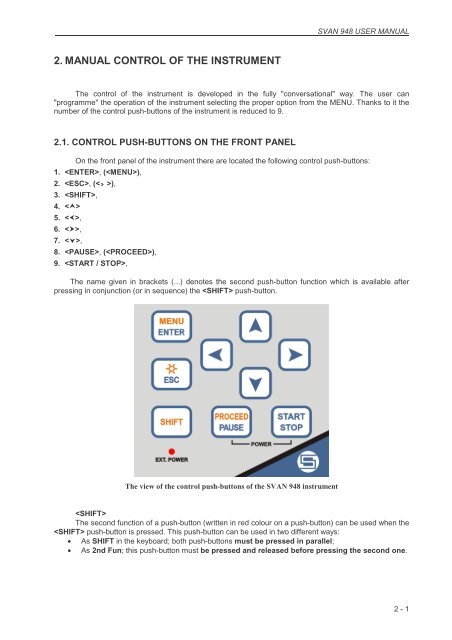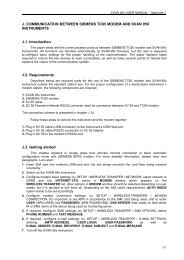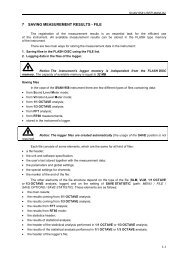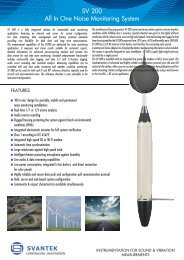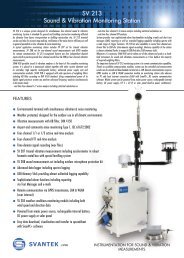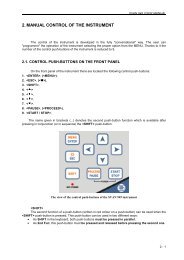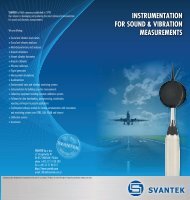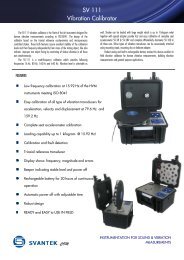2. MANUAL CONTROL OF THE INSTRUMENT - Svantek
2. MANUAL CONTROL OF THE INSTRUMENT - Svantek
2. MANUAL CONTROL OF THE INSTRUMENT - Svantek
Create successful ePaper yourself
Turn your PDF publications into a flip-book with our unique Google optimized e-Paper software.
<strong>2.</strong> <strong>MANUAL</strong> <strong>CONTROL</strong> <strong>OF</strong> <strong>THE</strong> <strong>INSTRUMENT</strong><br />
SVAN 948 USER <strong>MANUAL</strong><br />
The control of the instrument is developed in the fully "conversational" way. The user can<br />
"programme" the operation of the instrument selecting the proper option from the MENU. Thanks to it the<br />
number of the control push-buttons of the instrument is reduced to 9.<br />
<strong>2.</strong>1. <strong>CONTROL</strong> PUSH-BUTTONS ON <strong>THE</strong> FRONT PANEL<br />
On the front panel of the instrument there are located the following control push-buttons:<br />
1. , (),<br />
<strong>2.</strong> , (),<br />
3. ,<br />
4. <br />
5. ,<br />
6. ,<br />
7. ,<br />
8. , (),<br />
9. ,<br />
The name given in brackets (...) denotes the second push-button function which is available after<br />
pressing in conjunction (or in sequence) the push-button.<br />
The view of the control push-buttons of the SVAN 948 instrument<br />
<br />
The second function of a push-button (written in red colour on a push-button) can be used when the<br />
push-button is pressed. This push-button can be used in two different ways:<br />
• As SHIFT in the keyboard; both push-buttons must be pressed in parallel;<br />
• As 2nd Fun; this push-button must be pressed and released before pressing the second one.<br />
2 - 1
SVAN 948 USER <strong>MANUAL</strong> .<br />
Notice: The operation of this push button can be set as the “Shift” mode or the “2nd Fun.”<br />
mode in the SHIFT MODE window of the SETUP list (see Chapter 5 for the SETUP list description).<br />
<br />
This push-button enables one to start the measurement process, when the instrument is not<br />
measuring or to stop it, when the instrument is measuring. It is also possible to set such mode of this<br />
push-button, in which in order to start or stop the measurements the user has to press it simultaneously<br />
with the one.<br />
Notice: The changing of the push-button mode is performed in the<br />
SHIFT MODE window of the SETUP list (see Chapter 5 for the SETUP list description).<br />
<br />
This push-button enables one to break temporary the measurement process. The last one second<br />
measurement result is deleted after the subsequent pressing of the push-button. Up to fifteen<br />
last seconds of the measurement can be cancelled in this way.<br />
()<br />
This push-button (pressed together with the one) enables the user to continue the<br />
measurement process stopped temporary by pressing the push-button.<br />
Notice: The simultaneous pressing of the and push-buttons<br />
switches the instrument on and off.<br />
<br />
This push-button enables one to enter the selected operation mode or to confirm control options.<br />
Some additional functions of this push-button will be described in the following chapters.<br />
()<br />
This push-button (pressed together with the one) enables the user to enter the main list<br />
containing six sub-lists: FUNCTION, INPUT, DISPLAY, FILE, AUX. FUNCTIONS and SETUP. Each<br />
of the mentioned above sub-lists consists of the sub-lists, elements and data windows. These main sublists<br />
will be detailed described in the following chapters of the manual. Double pressed pushbutton<br />
enters the list containing four last opened sub-lists. It often speeds up the control of the instrument.<br />
<br />
This push-button closes the control lists, sub-lists or windows. It acts in opposite to the <br />
push-button. When the window is closed pressing the push-button, any changes made in it are (in<br />
almost all cases) ignored.<br />
()<br />
This push-button (pressed together with the one) enables the user to switch on or off the<br />
backlight of the screen and the keyboard.<br />
2 - 2
, <br />
These push-buttons enable one, in particular, to:<br />
SVAN 948 USER <strong>MANUAL</strong><br />
• select the options in an active position in the "horizontal direction" (e.g. filter: LIN, A or C, Integration<br />
time: 1s, 2s, 3s, … etc.),<br />
• select the measurement result to be displayed (e.g. PEAK, MAX, MIN, etc.) in One Profile and<br />
3 PR<strong>OF</strong>ILES modes of result’s presentation),<br />
• control the cursor in SPECTRUM, PLOT and STATISTICS modes of result’s presentation,<br />
• select the position of the character in the text edition (i.e. in the FILE NAME menu).<br />
(, )<br />
The , push-buttons pressed in conjunction (or in sequence) with the enable one,<br />
in particular, to:<br />
• speed up the changing of the numerical values of the parameters (i.e. the step is increased from 1 to<br />
10 in the setting of START DELAY).<br />
• insert or delete a character in the text edition modes,<br />
• change the statistics class (the number displayed after the letter L) in One Profile and 3 PR<strong>OF</strong>ILES<br />
modes of result’s presentation,<br />
Some other possible reactions of the instrument on the pressing of these push-buttons will be<br />
described in details in the following chapters.<br />
, <br />
The , push-buttons enable one, in particular, to:<br />
• change the mode of result’s presentation,<br />
• select the proper character from the list in the text edition mode,<br />
• switch the active sub-list in a list.<br />
• programme the Real Time Clock (RTC) and TIMER.<br />
Some other possible reactions of the instrument on the pressing of these push-buttons will be<br />
described in details in the following chapters.<br />
(, )<br />
The , push-buttons pressed in conjunction (or in sequence) with the enable one,<br />
in particular:<br />
• change the relation between the Y-axis and X-axis of all plots presented on the screen,<br />
• switch the channels and profiles in One Profile and STATISTICS modes of result’s presentation,<br />
• switch the active channel in 3 PR<strong>OF</strong>ILES mode of result’s presentation<br />
Some other possible reactions of the instrument on the pressing of these push-buttons will be<br />
described in details in the following chapters.<br />
2 - 3
SVAN 948 USER <strong>MANUAL</strong> .<br />
<strong>2.</strong><strong>2.</strong> INPUT AND OUTPUT SOCKETS <strong>OF</strong> <strong>THE</strong> <strong>INSTRUMENT</strong><br />
The measurement inputs, called Channels, are placed on the top cover of the instrument. There<br />
are 4-pins Lemo compatible socket type ENB.0B.304 – Channels 1-3 and TNC – Channel 4, all with<br />
IEPE power supply for the accelerometers or microphone preamplifiers. The microphone preamplifier<br />
SV 12 has the proper plug-in with the screw for direct connection with the instrument but it is<br />
recommended to use the preamplifier with any extension cable or gooseneck. The vibration transducer<br />
attached to the unit has to have the same connector.<br />
Notice: Pay attention that the TNC connector should be always twisted to the light resistance<br />
but the Lemo connector is push-pull only.<br />
2 - 4<br />
The full description of the signals connected to the sockets is given in the Appendix C.<br />
The view of the top cover of the SVAN 948 instrument in 1:1 scale<br />
In the bottom cover three sockets exist: USB (in the figure below in the middle), AC / Int. (in the<br />
figure below in the left side) and Ext. Power (in the figure below in the right side).<br />
The view of the bottom cover of the SVAN 948 instrument in 1:1 scale<br />
The USB 1.1 interface is the serial interface working with 12 MHz clock. Thanks to its speed this<br />
interface is widely used in all PC. In the instrument the standard 4-pins socket is used described in details<br />
in Appendix C.<br />
The additional input / output socket, called AC / Int., is 1-pin LEMO compatible socket type<br />
ERN.00.250 (the left one in the Fig. above). The function of this socket can be selected from menu (path:<br />
MENU / SETUP / EXT. I/O SETUP / MODE). The socket can be used as:
SVAN 948 USER <strong>MANUAL</strong><br />
• analogue output with the signal from the input of the analogue / digital converter (before the<br />
correction); this signal can be registered using magnetic recorder or observed on the oscilloscope (the<br />
ANALOG setting)<br />
• digital input for external interrupt (the DIGITAL IN setting)<br />
• digital output for external trigger (the DIGITAL OUT setting)<br />
The Ext. Power socket located on the bottom cover of the instrument is Marushin MJ-14<br />
compatible socket, dedicated for the standard Φ 5.5 / <strong>2.</strong>1 mm plug (the right one in the Fig. above). The<br />
user can connect the external mains adapter (110 V / 230 V) which furnishes the proper DC level. The<br />
instrument can be charged from the external DC source (from 6 V to 24 V). The current consumption<br />
depends on the voltage of the power supplier.<br />
Notice: Switch the power off before connecting the instrument to any other device (e.g. a<br />
printer or a Personal Computer).<br />
The view of the front panel of the SVAN 948 instrument in 1:1 scale<br />
2 - 5
SVAN 948 USER <strong>MANUAL</strong> .<br />
2 - 6<br />
The view of the rear panel of the SVAN 948 instrument in 1:1 scale


